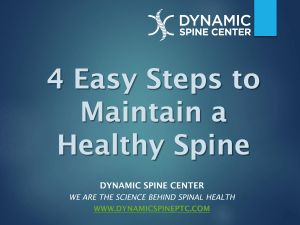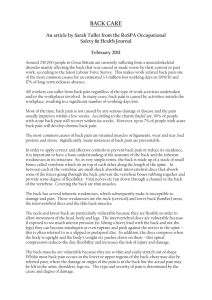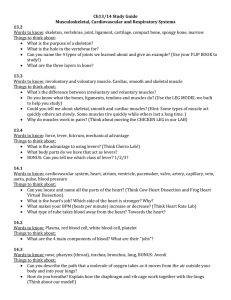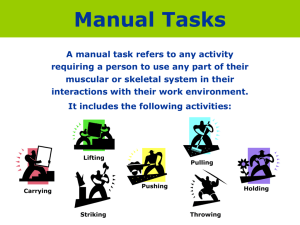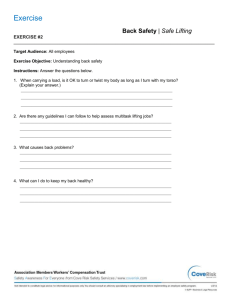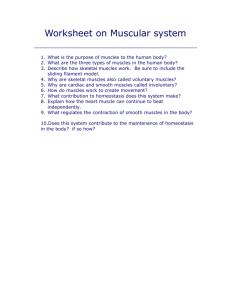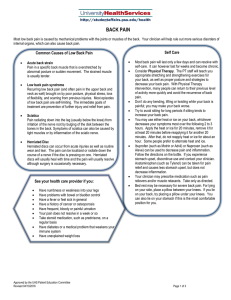Manual Handling - Disability Safe
advertisement
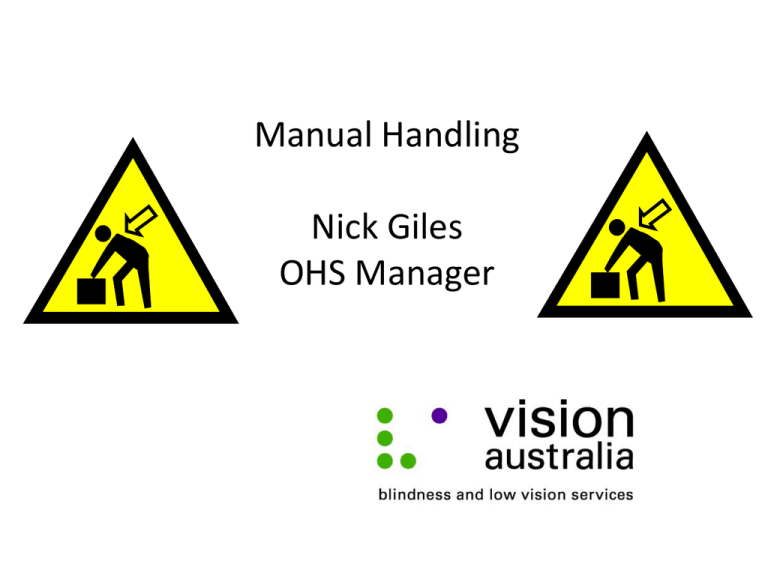
Manual Handling Nick Giles OHS Manager What is Manual Handling? “ any activity requiring the use of force exerted by a person to lift, push, pull, carry or otherwise move, hold or restrain any object ” OR “Anything you need to use your muscles for” ! Manual Handling • About 60% of workplace injuries across all injuries are caused by manual handling • Injuries usually involve the back, neck or shoulders Injuries Sudden – eg from lifting something heavy Wear and tear – eg from repetitive work Attitudes to Being Injured • • • • Bad luck Fate Injuries are caused by being careless Haven’t been injured before so unlikely to happen in the future • Most people think it wont happen to them • OHS Says that every injury is preventable What Makes a Manual Handling Task Hazardous • High force – lifting something really heavy, pushing a heavy trolley, straining • Unsafe awkward posture – bending / twisting • Sustained work – holding a heavy item for some time • Repetitive work – using the same muscles, tendons, ligaments over and over • Unstable / unbalanced loads which are difficult to grasp Exercise 1: List Manual Handling Tasks FACTORS CONTRIBUTING TO MANUAL HANDLING INJURY Poor Fitness Poor Techniques/ Posture Environmental Hazards Inadequate Equipment WORKPLACE INJURY Lack of Work Experience/ Formal Training Unsafe Work Practices/ Difficult Tasks Structure & Function of the Spine Function - support body in an upright posture, and protect the spinal cord. Structure - Spinal column is made of: • Vertebrae (bony segments) • Discs (cushion the vertebrae; act as shock absorbers) • Spinal cord (nerves) Muscles Supporting the Spine • Back muscles (superficial long muscles/deep short muscles attaching to vertebrae) • Abdominal muscles (broad, sheet like muscles that run diagonally in both directions & provide support to spine in lifting) These muscles provide much of the support for your back and spine All these muscles are prone to injury during unsafe manual handling. Spine Anatomy – Straight Back There are 3 curves: Cervical (inward); Thoracic (outward); Lumbar (inward). As We Get Older • We can be more prone to injury • It takes longer to recover from an injury • The back becomes less flexible Your Role Know your own capabilities Size up the risks involved in each task Work out the safest way of undertaking the task Feedback your ideas about risky tasks and solutions to managers/health and safety representatives You may be asked to help complete risk assessments Report all incidents hazards and near misses Tactics • Plan ahead • Don’t rush • Unusual / unfamiliar task – step back and think about how to do it safely Practical Techniques to Reduce Injury Correct posture Safe lifting technique Ordering smaller packages Store heavy and frequently used items between shoulder and hip height Using a trolley Making best use of our available storage space Plan ahead when moving items Avoid twisting by moving your feet Stretch / warm up before manual handling ! Risk Control Eliminate Eg. Avoid double handling, deliver to point of storage Substitution More Effective Eg. Order smaller packages Engineering eg trolley, lever, handle Administrative Eg. Training, warning signs, job rotation Less Effective Exercise 2: Risk Assessment Safe Lifting Technique • • • • • Size up the load Move as close to the load as possible Always bend your knees, tighten your abs Raise the load using your leg muscles Turn by moving your feet Hug Your Load Keeping a Straight Back • Kneel instead of bending • Squat • Lunge Work Smarter Not Harder Benefits of safer manual handling • Not getting injured • More energy when you go home from work – you’ll enjoy life more. • Be fit and healthy into old age Other Tactics • Stretching exercises – before, during, after work • Getting enough rest • Keeping fit Outside of Work • Look after yourself at home too – Gardening – Moving house – Moving furniture – Working on the car – Lifting the kids – Helping mates
